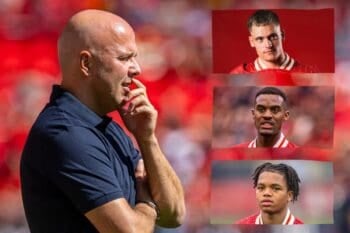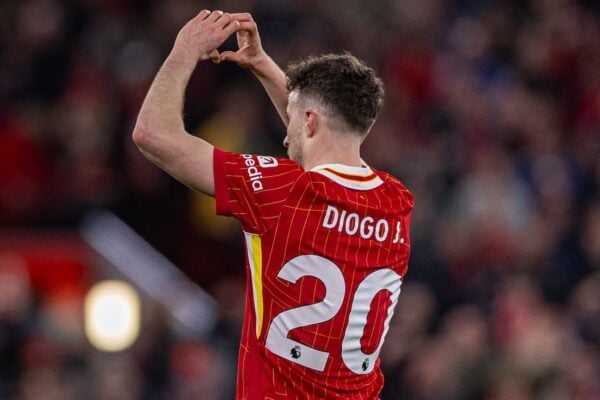As Brendan Rodgers’ first season in charge at Liverpool comes to a finish, Kopology takes a tactical look at the campaign and provides reasons for optimism going forward.

Football managers often enjoy a ‘honeymoon period’ when taking over at a new club. Not so for Brendan Rodgers at Liverpool. With his every utterance and mannerism scrutinised on Being: Liverpool, and the tests of Arsenal, Man City and United in his first five fixtures, some Liverpool fans were filing for divorce even before the young groom had chance to cut the cake.
For some, Rodgers is the conduit for anger over the sacking of Kenny Dalglish, while for others his crime is simply not being Rafael Benitez. For every fan who thinks he and Liverpool are a potential match made in heaven, another cries #RodgersOut with each disappointing result.
The squad he inherited had only managed an 8th-placed finish the previous season, and from that group Dirk Kuyt, Maxi Rodriguez, and Craig Bellamy – as well as the already somewhat absent Fabio Aurelio, Charlie Adam and Alberto Aquilani – were pruned. That left only Luis Suarez and Andy Carroll as out-and-out attackers, and a painfully young, thin squad including several players (Carroll and Coates particularly) ill-suited to Rodgers’ philosophy.
Without a huge budget to spend on reinforcements (£25m isn’t a lot when the team who finished sixth are splashing more on a single player) fans with a sense of perspective understood that this would be a season of transition. The realities of transition, however, are far harder to swallow than the concept, and even some of the most level-headed fans have come close to forgetting that Rome wasn’t built in a day.
Yet no-one can deny that this team has some problems in need of addressing. Most obviously, the midfield lacks cohesion, but like a sportsman suffering repeated hamstring pulls because of an underlying back problem, this is in part a symptom of a more fundamental, deeper-rooted issue in defence. While managers often start by building from the back, the lack of attacking players meant Rodgers had to focus on the other end of the pitch. With the additions of Sturridge, Coutinho and Borini, he can now turn his attention to the creaking foundations.
Pace at the Back and a High Defensive Line
A lack of pace in defence is a problem that reverberates throughout the side, affecting both the build-up and attacking play as other players have to adjust their positions to stay within passing distance of those behind them. The risk of a high defensive line* is always that with a large space left between the defenders and the goalkeeper, it takes just one dink over the top or carefully threaded through-ball in unison with a well-timed run, and a striker is baring down on goal with only the keeper to beat.
This is why teams often sit deep when defending against quick forwards, to close the space between defence and goalkeeper, as many did when visiting Anfield while Torres was in his pomp. But a combination of quick defenders who can recover to catch a forward through on goal, and a sweeper-keeper positioned on the edge of his box to quickly rush out can effectively neutralise the threat. Of course, a well-drilled offside trap is vital to stop strikers getting in behind in the first place. Arsenal’s ‘invincibles’ perfected this way of camping out in the opposition half, and are perhaps a good model for the kind of team Rodgers is trying to build.
In Martin Skrtel and Daniel Agger, Liverpool’s defensive partnership was mobile, if not blessed with lightening speed. When Skrtel’s lack of aerial dominance and positional awareness became too much of a liability, however, Rodgers had little choice but to replace him with the ageing Jamie Carragher. Pace was never one of Carra’s strong points, but at 35, there are few strikers that wouldn’t outrun him in a race. In solving one problem with the least-worst option, Rodgers compounded another, and Carra’s inclusion necessitated a deeper defensive line, which has inherent weaknesses of its own.
By sitting deep you give opponents the option of firing long balls and crosses in the air to a big player like Andy Carroll taking up positions close enough to goal to be a threat. If a defence instead position themselves on the halfway line, a player like Carroll must stay onside, lacks the pace to beat an offside trap, and can do little damage with headers from distance. Defend from within your own area, and it’s imperative that centre-backs win a high percentage of balls in the air.
The different threats posed by pace and aerial ability explain why, for so long, the Big Man-Small Man combo was so popular. Drop back, and a tall, powerful striker can get his head on the end of crosses. Push up, and a quick, agile forward can break the offside trap and get in behind the defense. It’s only with the relatively modern emergence of defenders who are both quick and good in the air that the Toshack-Keegan style attack has become less popular.
Had we not so badly needed attacking reinforcements, Rodgers would likely have signed a centre-back in January, and this will be his priority come summer. Martin Kelly is doubly unlucky, because the crisis at the back could have precipitated his long-expected breakthrough in central defence had he not been ruled out for so long with injury. Long term, Andre Wisdom has all the essential attributes, but for now, the biggest single tweak Brendan Rodgers can make to the team is signing a defender who is competent in the air, a good organiser, and most important of all, one who provides ample pace.
[*I’d like to see Opta produce statistics on teams’ Average Defensive Line in games, as I think it could tell us more about playing styles and dominance than possession statistics do]
Pressing Matters: Balance and Bulk in Midfield
The other obvious issue Rodgers needs to address is the balance – or lack thereof – in midfield, and this too is in part down to a dearth of pace at the back. Rodgers obviously wants us playing a short passing game on the floor, which is most effective when players are relatively close together. If you watch Barcelona, their passes to one-another are sometimes no more than a meter in length, often taking the ball from each other’s toes as they interchange positions and exchange intricate one-twos.

The problem is that Agger is playing close to his own box, and the most advanced attacker is around the same position at the other end, making it hard for a three-man midfield to stay within short passing distance of both. If Lucas drops deep to receive the ball from the centre backs, Gerrard has to follow suit to give him a passing option, and soon a big gap opens up between the midfield and attack. If the midfield players try to push up closer to the attackers, a gap opens up behind them, allowing opponents to run at our defenders with the ball through the middle – something we’ve seen all too often this season.
As in defence, the problem is a symbiotic combination of tactics and personnel. If the defense were pushed up higher, the space between defenders and attackers would be smaller, and our three midfielders could cover and close it down more efficiently, but were also not helped by Lucas and Gerrard’s lack of mobility. Once upon a time that would have been a bizarre thing to say about Gerrard, but clearly his lungs and legs aren’t what they once were, and he struggles to get around the pitch like he once did. Lucas is yet to regain his best form after two long spells out, but even if he does, he’s better at nipping in and stealing the ball in tight areas than shielding the defence and stopping midfielders running from deep at full pelt. Lucas isn’t the biggest or most physically imposing defensive midfielder around, either, and in a team already containing several diminutive players, his is a position where it might make sense to add some bulk.
To use that great Arsenal side as an example again, Liverpool lack the presence of a Patrick Vieira in midfield, but none of Gilberto, Ljungberg, Pires, Bergkamp or Henry were physically slight, either. After the mishaps against Oldham, Spurs and Southampton, Rodgers appears to have put to bed notions of just two central midfielders and Suarez in the hole, but if he had two sturdier options than Lucas and Gerrard – as Wenger did in Vieira and Gilberto – they could provide the necessary balance to make the system work.
Rodgers arrived at Liverpool with much talk of high pressing and resting on the ball, but these characteristics have largely failed to materialise on the pitch. It does make sense that both – as opposed to just one – of these methods have been abandoned, though. A team that presses with high energy tires quickly, and taking a breather when in possession compensates for the extra effort. If you don’t press, you don’t need to rest. But why abandon the pressing game in the first place? We started the season pressing, but seemed to ease off as the months went by. With such a thin squad, Lucas returning from injury and Gerrard in the twilight of his career, it’s likely Rodgers and his team decided the level of pressing they would ideally like couldn’t be maintained, so a compromise was made.
Once again, the lack of pace in defence – and the resulting deep defensive line – was a factor. When Barcelona attack, they advance as one unit, playing the ball around and allowing defenders to advance up the pitch as attacks are built, instead of leaving them stranded behind the play. This means that when the ball is lost and midfielders try to win it back quickly by pressing high up the pitch, they do so in a more crowded area and aren’t leaving a huge space between themselves and the defenders. Instead, as discussed before, the space is left between the quick defenders and sweeper-keeper.
Lacking the quick defenders for a high defensive line and mobile central midfielders, Rodgers limited the amount of pressing asked of the team. But with the right defensive signings in the summer, and perhaps with a midfielder or two better suited to closing players down, we can expect to see more pressing and resting come next season.
Once Bitten, Twice Shy: Incremental Change and the Luis Suarez Conundrum
Perhaps the biggest issue of all remains what to do with the unique blend of irascibility and genius that is Liverpool’s No.7. If he is to stay, the club desperately need to get to the root of Luis Suarez’s disciplinary issues. The media’s reaction is one of predictable outrage – in contrast to the response when Jermaine Defoe sunk his fangs into Javier Mascherano – such is the desire to see Liverpool part ways with a talent as rare as it is irreplaceable. That should not detract from the seriousness of Suarez’s behaviour. It seems clear that the Uruguayan has underlying anger issues which should be addressed responsibly by the club. That means rehabilitation, and if necessary, therapy, but selling him only sends the problem elsewhere, and is far from a ‘moral’ course of action.
Aside from his behavioural issues, should we retain the Uruguayan’s services it’s still unclear exactly where he should be deployed long-term. Questions over his ability as a goal-scoring frontman have been answered emphatically, but it may be that the team would be stronger with him starting from one of the wide positions, or indeed, operating from what Rodgers refers to as the ‘Zola-zone’ between midfield and attack.
As readily as some fans complain that our young manager is too naïve and idealistic for a big club like Liverpool, others grumble that he has compromised his methods and failed to implement the Tiki-Taka passing, high pressing, and resting on the ball we were promised. But are these tropes not somewhat mutually exclusive? As it often does, the truth lies somewhere in-between.
Not that it should be a mystery. Speaking of his time at Reading in an early Liverpool press conference, Rodgers admitted: “I went in there looking to change things too quickly. I went in thinking ‘Right, the club want a new vision, a new philosophy’ and I felt if I stripped it down quickly and let it build then that would be okay.”
It wasn’t. Rodgers tried to change too much too soon, and was sacked within six months. But he learned from his mistake, and realised that Rome was not built in a day. Perhaps it’s time we did too, because with the addition of a few more players with quality, strength and pace, the romance could yet blossom.
















Fan Comments